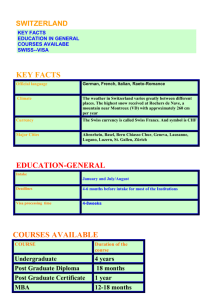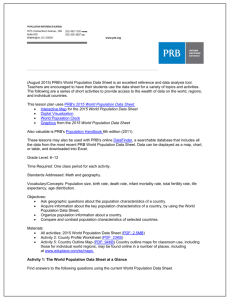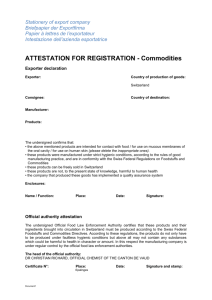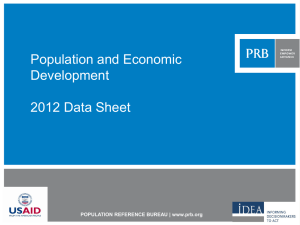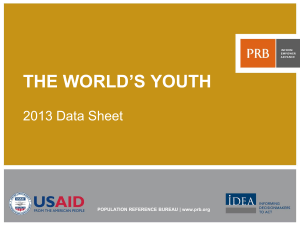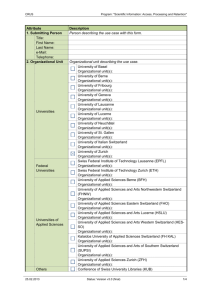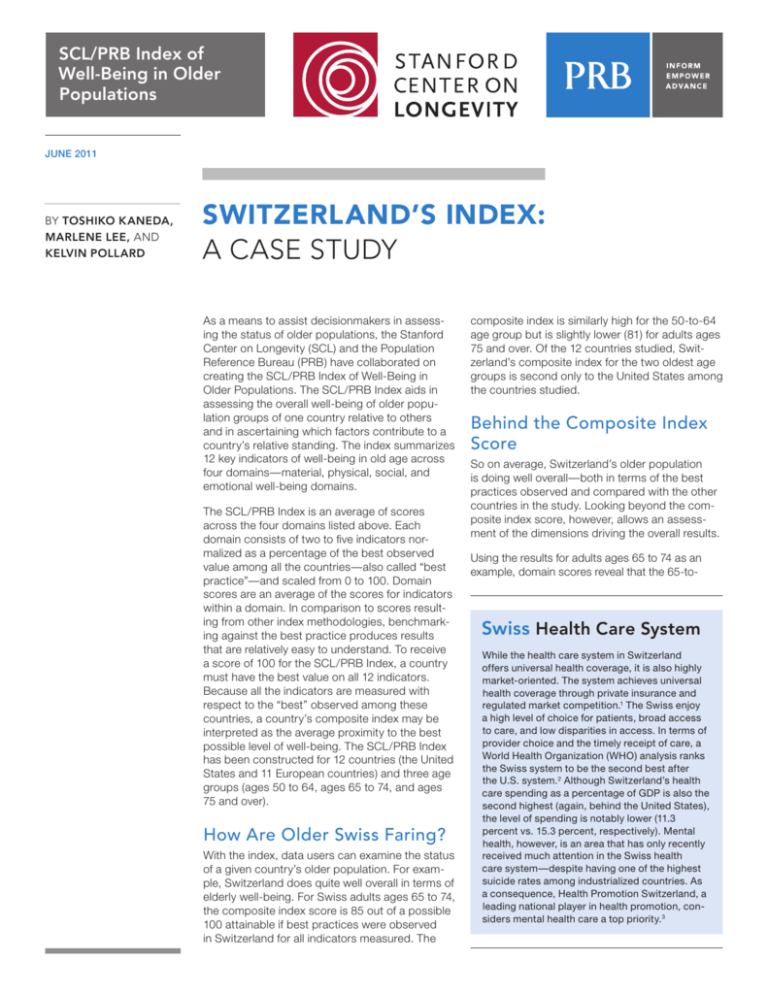
SCL/PRB Index of
Well-Being in Older
Populations
JUNE 2011
BY TOSHIKO KANEDA,
MARLENE LEE, AND
KELVIN POLLARD
SWITZERLAND’S INDEX:
A CASE STUDY
As a means to assist decisionmakers in assessing the status of older populations, the Stanford
Center on Longevity (SCL) and the Population
Reference Bureau (PRB) have collaborated on
creating the SCL/PRB Index of Well-Being in
Older Populations. The SCL/PRB Index aids in
assessing the overall well-being of older population groups of one country relative to others
and in ascertaining which factors contribute to a
country’s relative standing. The index summarizes
12 key indicators of well-being in old age across
four domains—material, physical, social, and
emotional well-being domains.
The SCL/PRB Index is an average of scores
across the four domains listed above. Each
domain consists of two to five indicators normalized as a percentage of the best observed
value among all the countries—also called “best
practice”—and scaled from 0 to 100. Domain
scores are an average of the scores for indicators
within a domain. In comparison to scores resulting from other index methodologies, benchmarking against the best practice produces results
that are relatively easy to understand. To receive
a score of 100 for the SCL/PRB Index, a country
must have the best value on all 12 indicators.
Because all the indicators are measured with
respect to the “best” observed among these
countries, a country’s composite index may be
interpreted as the average proximity to the best
possible level of well-being. The SCL/PRB Index
has been constructed for 12 countries (the United
States and 11 European countries) and three age
groups (ages 50 to 64, ages 65 to 74, and ages
75 and over).
How Are Older Swiss Faring?
With the index, data users can examine the status
of a given country’s older population. For example, Switzerland does quite well overall in terms of
elderly well-being. For Swiss adults ages 65 to 74,
the composite index score is 85 out of a possible
100 attainable if best practices were observed
in Switzerland for all indicators measured. The
composite index is similarly high for the 50-to-64
age group but is slightly lower (81) for adults ages
75 and over. Of the 12 countries studied, Switzerland’s composite index for the two oldest age
groups is second only to the United States among
the countries studied.
Behind the Composite Index
Score
So on average, Switzerland’s older population
is doing well overall—both in terms of the best
practices observed and compared with the other
countries in the study. Looking beyond the composite index score, however, allows an assessment of the dimensions driving the overall results.
Using the results for adults ages 65 to 74 as an
example, domain scores reveal that the 65-to-
Swiss Health Care System
While the health care system in Switzerland
offers universal health coverage, it is also highly
market-oriented. The system achieves universal
health coverage through private insurance and
regulated market competition.1 The Swiss enjoy
a high level of choice for patients, broad access
to care, and low disparities in access. In terms of
provider choice and the timely receipt of care, a
World Health Organization (WHO) analysis ranks
the Swiss system to be the second best after
the U.S. system. 2 Although Switzerland’s health
care spending as a percentage of GDP is also the
second highest (again, behind the United States),
the level of spending is notably lower (11.3
percent vs. 15.3 percent, respectively). Mental
health, however, is an area that has only recently
received much attention in the Swiss health
care system—despite having one of the highest
suicide rates among industrialized countries. As
a consequence, Health Promotion Switzerland, a
leading national player in health promotion, considers mental health care a top priority.3
74-year-old Swiss perform exceptionally well on two of the
four domains, but not quite as well on the other two domains
(see figure). For this age group, the domain score of 100 on
physical well-being means that Switzerland sets the standard
across the five indicators in this domain. The material wellbeing domain score is almost as high, 99 percent. Despite
ranking second on social engagement, Swiss adults ages
65 to 74 fare less well in this domain, with a domain score
of 83. But it is emotional well-being that really drags down
Switzerland’s composite index score for this age group, with
a domain score of only 59 percent for emotional well-being.
Among the 12 countries, Switzerland has only the fifth-highest
emotional well-being domain score for this age group.
Switzerland’s relatively low score on social connectedness—
the participation in activities such as employment, community organizations, or volunteer work (72 percent of the
standard)—offsets its high score on contact with children
(94 percent). And the reason for the country’s low emotional
well-being score can be tied to one measure: the high suicide rate among Swiss in this age group. Swiss adults ages
65 to 74 had just 18 percent of the top score on this measure, which weighs down the respectable achievements on
the depression and life satisfaction measures (73 percent for
percent not depressed and 86 percent for percent thriving).
These findings likely reflect the impact of an array of both
current and past social, economic, cultural, and political conditions in Switzerland. Reviewing the country’s health care
system (see box), for example, may provide some insights.
So what specific indicators are driving the domain scores for
65-to-74-year-old Swiss? Switzerland’s physical well-being
score of 100 results from setting the standard for that age
group on four of the domain’s five indicators. Similarly, the
country’s high material well-being score comes from achieving the highest per capita median household income and 98
percent of Sweden’s benchmark level for the percentage not
in absolute poverty. Lower scores on one indicator in each of
the two remaining domains are the reasons that Swiss fare
less well in these areas. In the social engagement domain,
Examining the Larger Picture
Understanding how well a nation’s older adults are faring
is critical in assessing the significant challenges population
aging poses, both today and in the coming decades. The
SCL/PRB Index of Well-Being in Older Populations summarizes complex and multiple dimensions of well-being in
old age. This is a useful tool for evaluating the overall level of
Distribution of Country Scores for SCL/PRB Index and Domains for Ages 65-74, 2004-2006
63
SCL/PRB INDEX
ES
GR
BE
DE FR AT
IT
53
MATERIAL
ES
GR
IT
DK
SE NL
FR
DK DE
BE
88
CH
US
AT
US
99
SE NL
CH
DE
DK
IT
US NL FR
ES BE AT SE
91 GR
PHYSICAL
58
SOCIAL
IT
DE
FR AT BE
ES
DE
40
CH
100
NL
SE
GR DK CH
US
75
43
EMOTIONAL
100
45
ES IT FR BE AT
SE
50
55
CH
NL
60
65
GR
US
DK
70
75
80
85
90
95
100
Index Score (0-100 scale)
Notes: AT=Austria; BE=Belgium; DK=Denmark; FR=France; DE=Germany; GR=Greece; IT=Italy; NL=Netherlands; ES=Spain; SE=Sweden; CH=Switzerland; US=United States. The
numbers at each end of the rows indicate the minimum and maximum scores in that domain.
Source: Population Reference Bureau.
2
www.prb.org
SWITZERLAND’S INDEX: A CASE STUDY
elderly well-being and for cross-national comparisons. However,
because no single country leads in all dimensions measured,
looking only to the leaders in the composite index misses valuable lessons the index has to offer. The domain scores help identify areas requiring improvement for a country and the countries
that might serve as models in those particular dimensions. Similarly, the indicator scores help pinpoint specific outcomes that
decisionmakers might wish to target and also identifies which
countries might have lessons to offer in making improvements on
that particular measure. By highlighting the areas requiring the
greatest attention for countries, the index can advance critical
debate on important issues confronting nations as the world’s
population ages.
References
1 R.E. Leu et al., The Swiss and Dutch Health Insurance Systems: Universal
Coverage and Regulated Competitive Insurance Markets (New York: The
Commonwealth Fund, 2009); and World Health Organization, The World
Health Report 2000—Health Systems: Improving Performance (Geneva: WHO,
2000).
2 Organisation for Economic Co-Operation and Development and World Health
Organization, OECD Review of Health Systems—Switzerland (Paris: OECD,
2006).
3 World Health Organization, The World Health Report 2000.
© 2011 Population Reference Bureau. All rights reserved.
Acknowledgments
Toshiko Kaneda is a senior research associate at the Population
Reference Bureau; Marlene Lee is program director, Academic
Research and Relations, at PRB; and Kelvin Pollard is a senior
demographer at PRB. This fact sheet was produced by the Population Reference Bureau with funding from the Stanford Center on
Longevity.
POPULATION REFERENCE BUREAU
The Population Reference Bureau INFORMS people around the world about
population, health, and the environment, and EMPOWERS them to use that
information to ADVANCE the well-being of current and future generations.
www.prb.org
POPULATION REFERENCE BUREAU
1875 Connecticut Ave., NW
Suite 520
Washington, DC 20009 USA
202 483 1100 PHONE
202 328 3937 FAX
popref@prb.org E-MAIL

